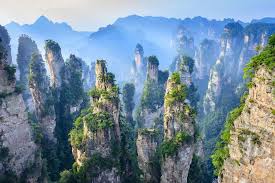Zhangjiajie National Forest Park, China
🏞️ Pillars of Heaven: Zhangjiajie National Forest Park, China
Rising like ancient monoliths from a green sea of mist, the towering sandstone pillars of Zhangjiajie National Forest Park are a dreamscape come to life. Located in Hunan Province, this UNESCO Global Geopark inspired the floating mountains in James Cameron’s Avatar — and in person, it feels even more surreal. With otherworldly rock formations, dizzying glass walkways, and tranquil forest trails, Zhangjiajie is China’s most mythical outdoor destination.
🌄 Avatar’s Ancestry: Land of Floating Peaks
The star attraction of Zhangjiajie is its 3,000 vertical quartzite sandstone pillars, some over 200 meters high, formed over millions of years of erosion. Blanketed in mist and foliage, these columns defy gravity and logic, earning the park its nickname, “The Avatar Mountains.”
Among the most iconic:
-
Hallelujah Mountain (formerly “Southern Sky Column”): Renamed after the movie, this is the park’s most photographed peak.
-
Yuanjiajie Scenic Area: Offers panoramic vistas of the pillar forest, accessed via the Bailong Elevator.
-
Tianzi Mountain: Known for its “Emperor’s View” and ocean of clouds — particularly magical at sunrise.
🚡 Engineering Marvels: Skywalks, Elevators & Bridges
Zhangjiajie is not only natural wonder — it's a showcase of gravity-defying human architecture.
-
Bailong Elevator: The world’s tallest outdoor elevator, this glass lift whisks you up 326 meters alongside a cliff face in under two minutes.
-
Zhangjiajie Glass Bridge: Suspended over the Zhangjiajie Grand Canyon, this see-through bridge stretches 430 meters and offers adrenaline-pumping views 300 meters above ground.
-
Tianmen Mountain Cable Car: The world’s longest cable car (7.5 km), it takes you from Zhangjiajie city up the mountain, offering a slow-motion aerial tour of the landscape.
🧭 Beyond the Pillars: What Else to Explore
Though most visitors come for the mountains, Zhangjiajie has so much more to offer:
-
Tianmen Mountain: Known as “Heaven’s Gate,” it features a natural rock arch 131 meters high. A dramatic road called the 99 Bends snakes its way to the summit.
-
Golden Whip Stream: A serene trail that winds through lush valleys alongside babbling water and monkeys swinging from trees.
-
Yellow Dragon Cave: An extensive karst cave system with massive chambers, underground rivers, and colorful stalactites.
🏯 Culture Among the Cliffs: Ethnic Villages & Traditions
Zhangjiajie is home to several of China’s ethnic minority groups, including the Tujia and Miao people. Their villages dot the outskirts of the park and provide a window into centuries-old customs.
-
Experience traditional stilted wooden houses, colorful batik fabrics, and lively folk dances.
-
Visit the Tujia Folk Custom Park to learn about local rituals and try regional crafts.
-
The cuisine here includes sour-spicy dishes unique to Hunan Province, often featuring smoked meats and mountain vegetables.
🏨 Stay in the Clouds: Where to Sleep
Zhangjiajie offers accommodation for every taste, from immersive eco-lodges to comfortable mid-range hotels and luxury resorts.
-
Pullman Zhangjiajie: A four-star option with international amenities near the park entrance.
-
Zhangjiajie No. 5 Valley Inn: Boutique lodging nestled in a quiet valley with mountain views and rustic-chic décor.
-
Tianzi Mountain Guesthouses: For adventurous travelers, basic stays within walking distance of viewing platforms.
Early booking is advised during peak seasons (April–June, Sept–Nov), especially near the national holidays.
🍜 Food Among the Peaks: What to Eat
Zhangjiajie’s cuisine is a spicy symphony reflective of Hunan flavors.
-
Suan La Fen: Hot and sour glass noodles, a popular street snack.
-
Smoked Bacon with Garlic Shoots: A fragrant Tujia specialty.
-
Steamed Fish Head with Chili: Not for the faint of heart but adored by locals.
-
Bamboo Rice: Sticky rice and meats steamed inside fresh bamboo tubes.
Mountain tea and rice wine from ethnic villages offer a cultural toast to every meal.
📅 Best Time to Visit
Zhangjiajie is a year-round destination, but each season brings its own magic:
-
Spring (Mar–May): Blooming flowers, fewer crowds, and cooler air.
-
Autumn (Sept–Nov): Crisp days, golden leaves, and peak photography conditions.
-
Summer (June–Aug): Lush and green but expect rain and tourists.
-
Winter (Dec–Feb): Snow-dusted peaks and mystical quiet — fewer visitors, but some areas may be closed.
🧳 Travel Tips & Essentials
-
Getting There: Fly into Zhangjiajie Hehua Airport or take a high-speed train from Changsha. Private transfers or local buses can take you to the park entrance.
-
Tickets: The park uses a one-ticket-multiple-entry system valid for four days. Shuttle buses inside the park are included.
-
Gear: Comfortable shoes are a must. Bring layers for altitude changes and a poncho if visiting in rainy season.
-
Crowds: Try to visit on weekdays and avoid Chinese national holidays like Golden Week.
⭐ Flyover Rating
-
Natural Beauty: ★★★★★
-
Adventure & Activities: ★★★★☆
-
Cultural Experience: ★★★★☆
-
Accessibility: ★★★☆☆


